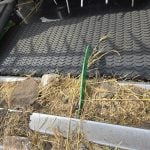Many new pulse varieties and fertilizer products have been released since most research was conducted on pulse sensitivity to fertilizer placed in the seed row.
That’s why Harshini Galpottage Dona, a masters of science student at the University of Saskatchewan, decided to revisit the topic while studying under Jeff Schoenau.
“She was interested in how fertilizer blends and combination nitrogen, phosphorus, sulfur products of higher nitrogen analysis effected pulse crop response when placed in the seed row,” Schoenau said.
“There really wasn’t a lot of information out there looking at fertilizer blends and these different combination products.”
Read Also

China’s grain imports have slumped big-time
China purchased just over 20 million tonnes of wheat, corn, barley and sorghum last year, that is well below the 60 million tonnes purchased in 2021-22.
The study was carried out largely in a controlled environment at the Saskatchewan Centre for Cyclotron Sciences, and it examined emergence, 30-day biomass, yield and nutrient uptake, in lentils, peas, chickpeas, soybeans, black beans and fababeans.
The six pulse crops were grown in optimal growing conditions in a loamy brown chernozem soil, low in available nitrogen, phosphorus, and sulfur.
Emergence and 30-day biomass production and nutrient uptake was looked at as a function of the fertilization.
“Overall, we saw limited yield response to starter nitrogen in the seed row. We also saw, and we had a companion field study, we saw reduced nitrogen fixation at the higher nitrogen amounts,” Schoenau said.
“So in terms of nitrogen fertilization, I think it says get that nitrogen out of the seed row, into a separate band.”
The study also found crop sensitivity to seed row placed nitrogen fertilizer.
When rates were applied above approximately 10 kilograms per hectare in lentils, peas and chickpeas, there was a significant reduction in emergence with those crops.
An application of 20 kg of nitrogen per hectare was safe for fababeans, soybeans and black beans.
“Soybean, black bean tended to be slightly more tolerant, fababean tended to be slightly more tolerant,” Schoenau said.
“As I said, we really didn’t see, overall, a whole lot of response to that starter nitrogen, and because of the high degree of sensitivity of crops to the injury, get it out of the seed row and into a separate band.”
















